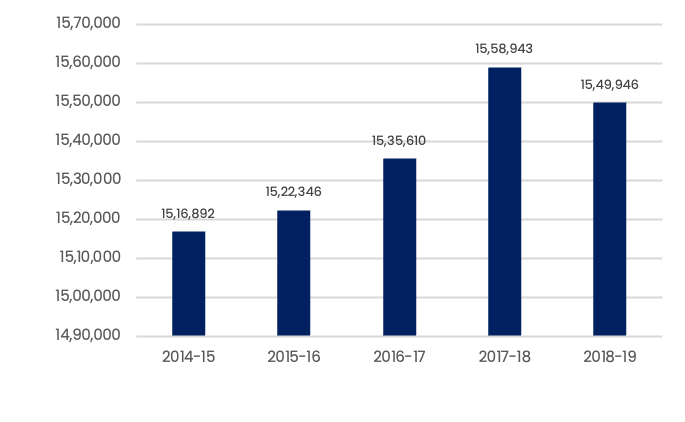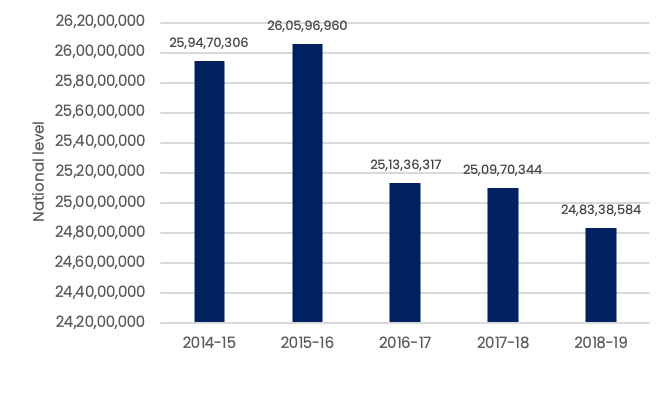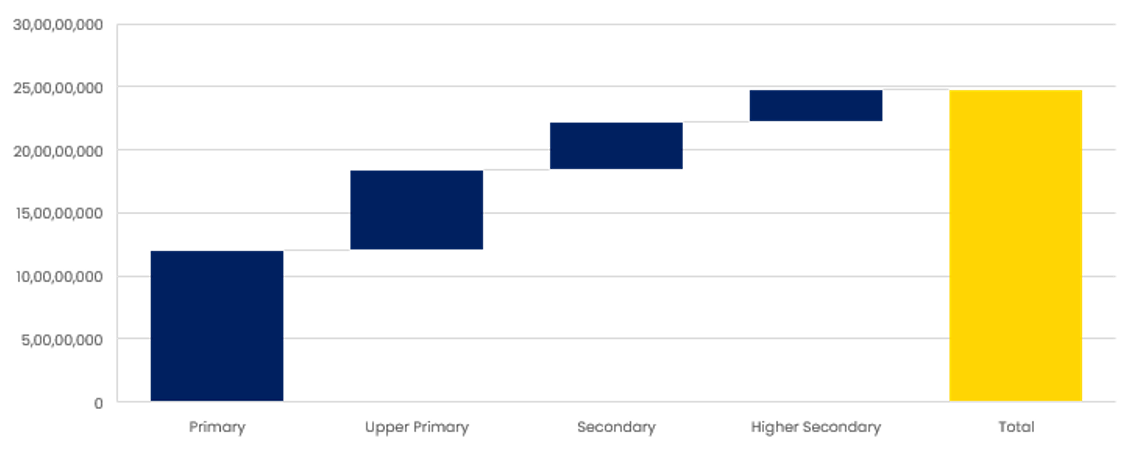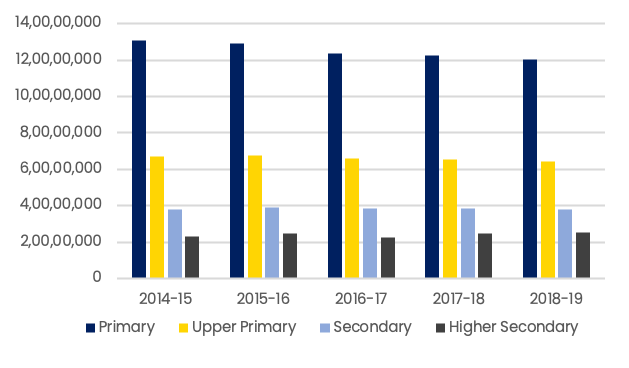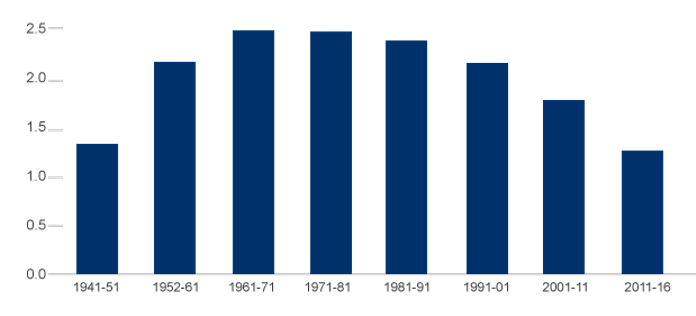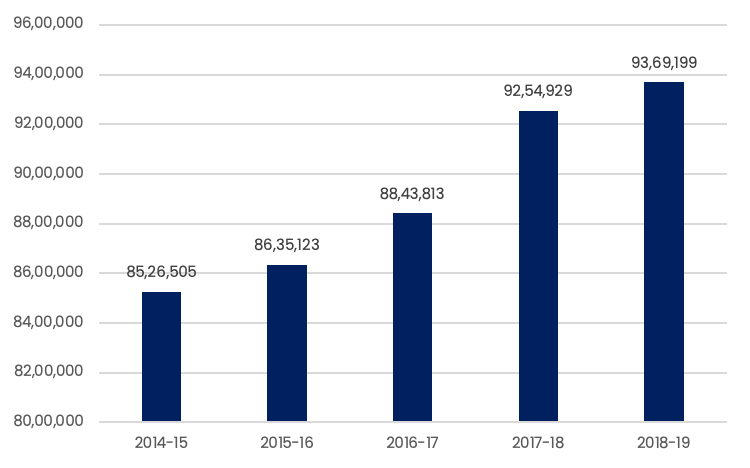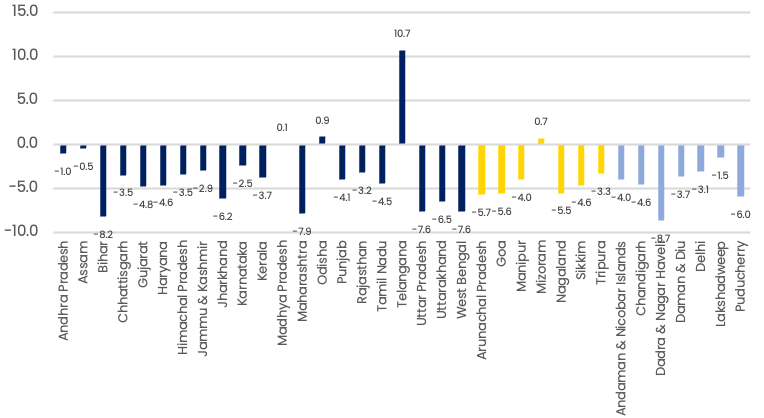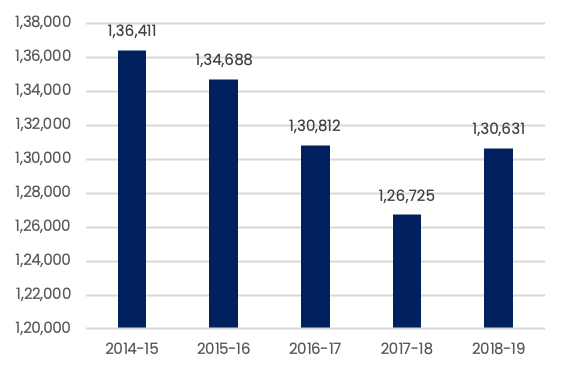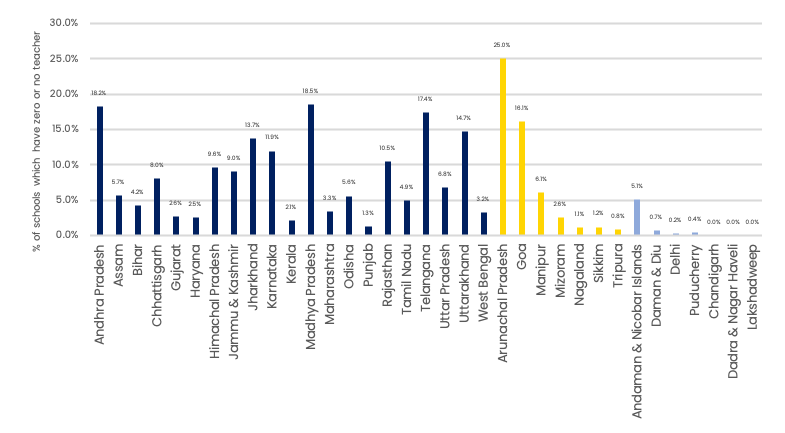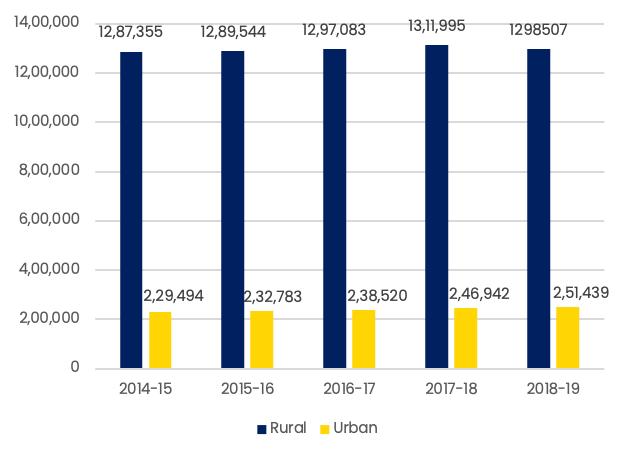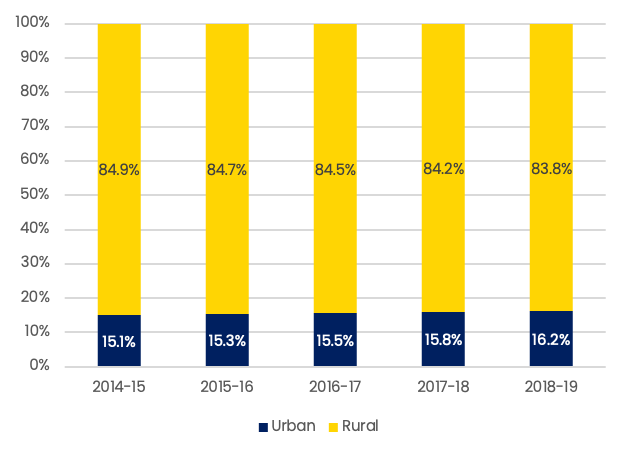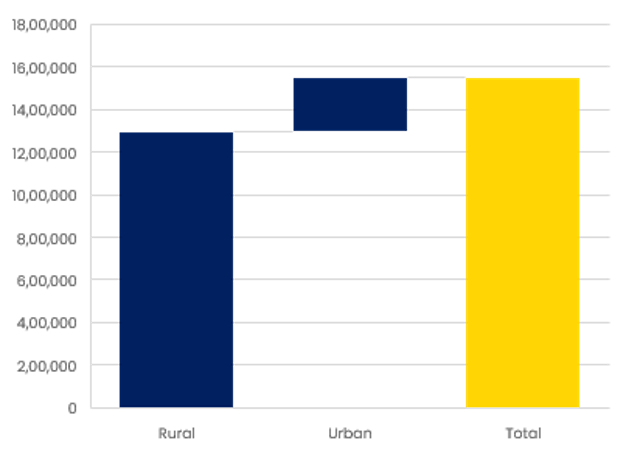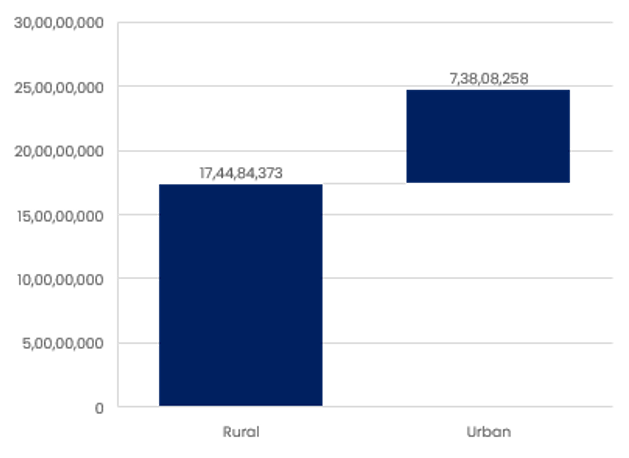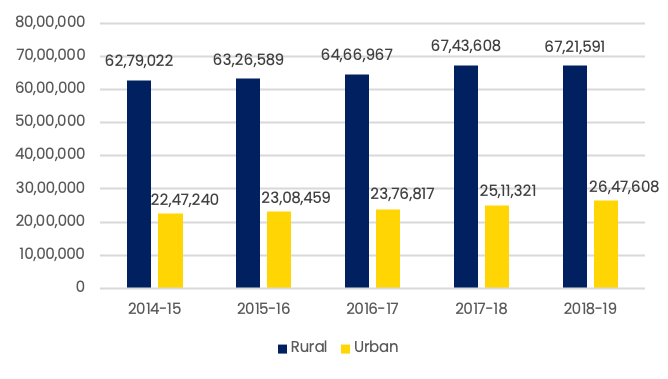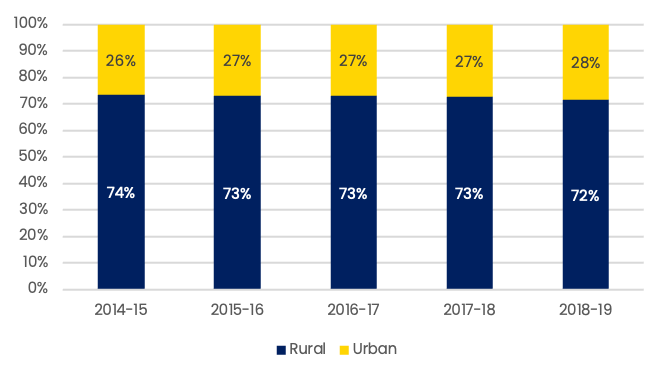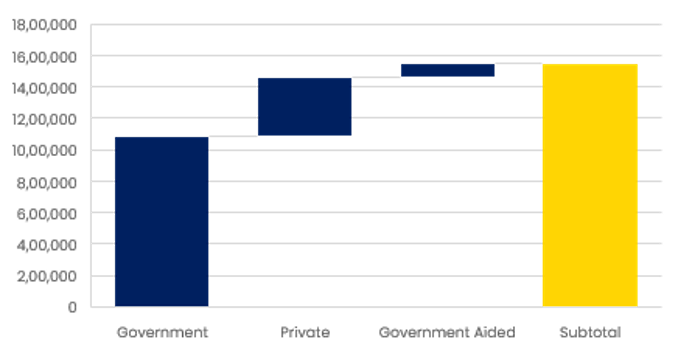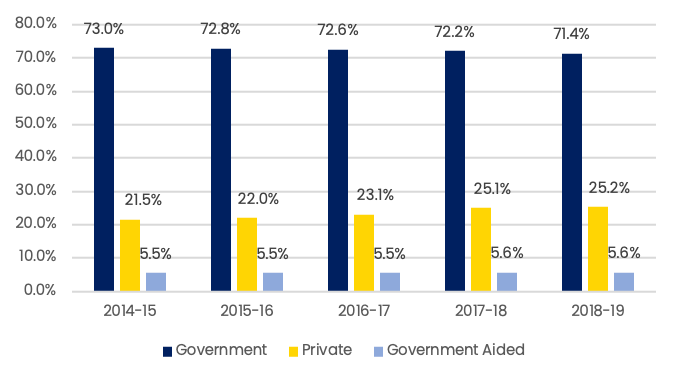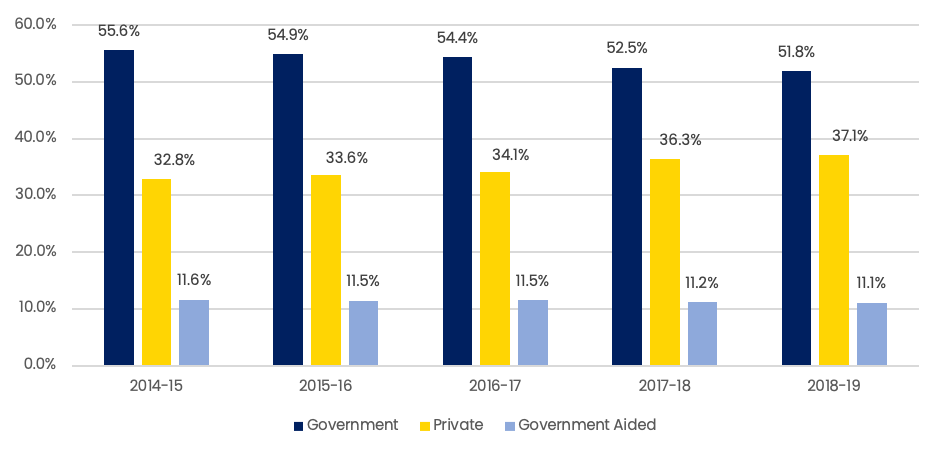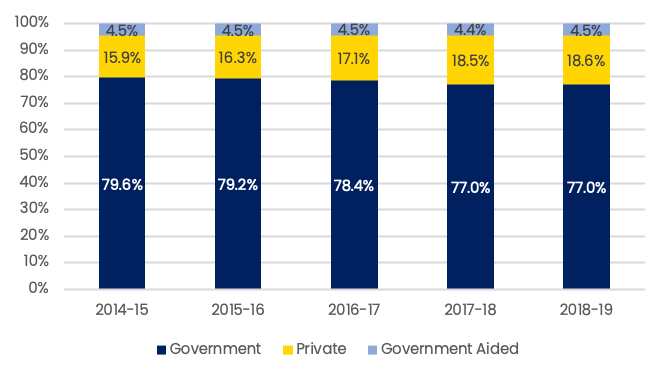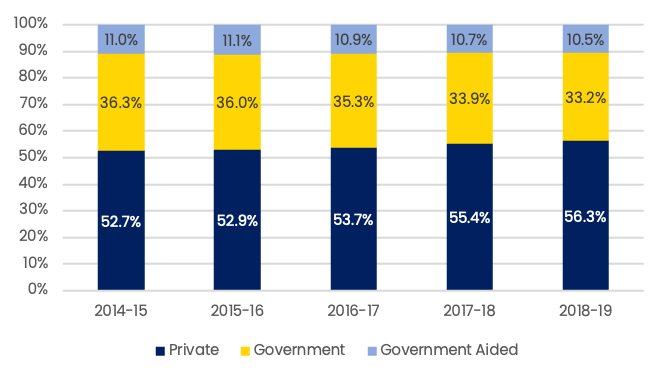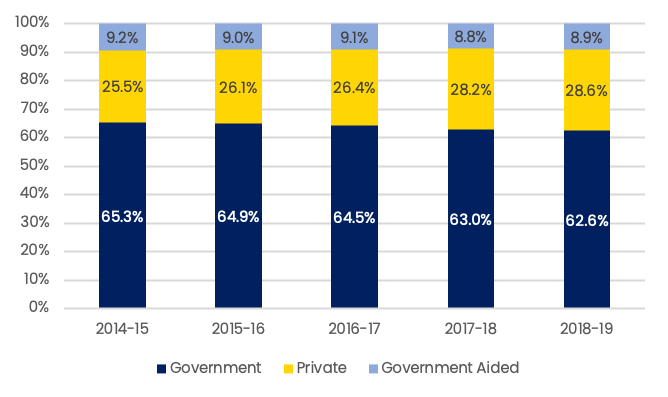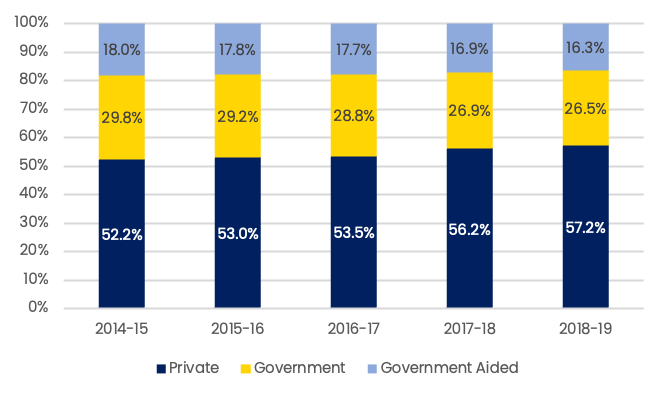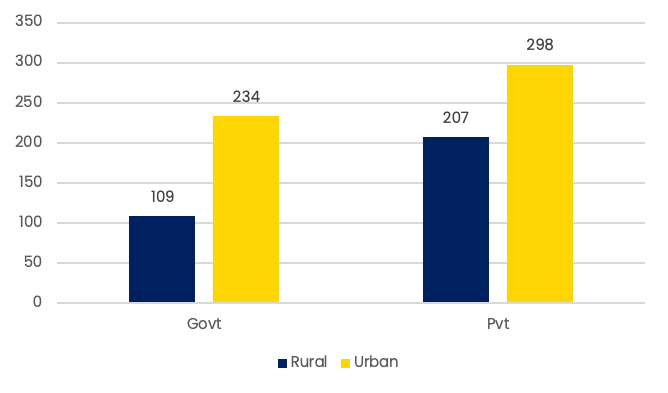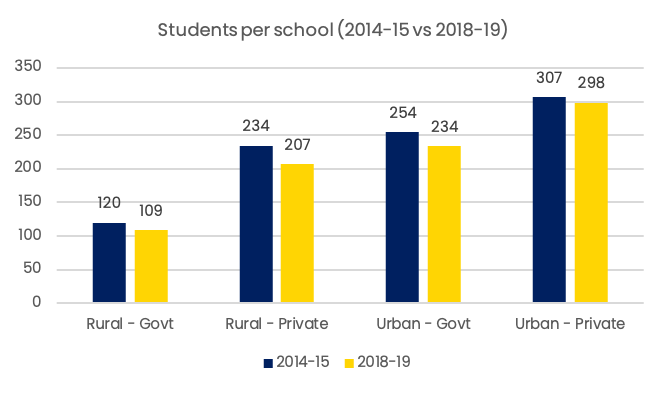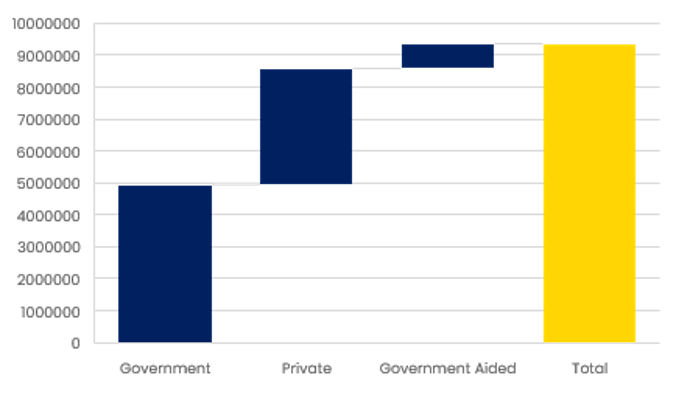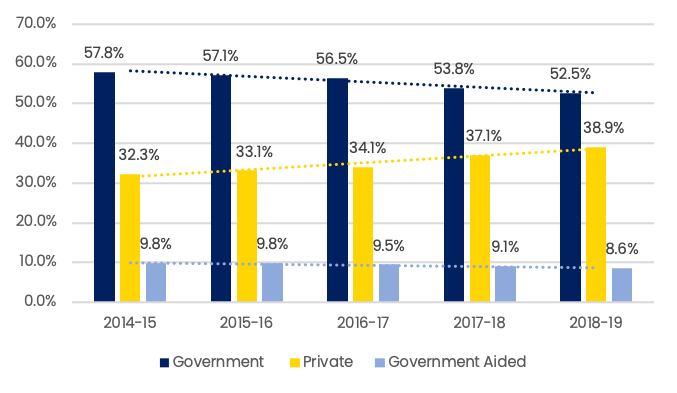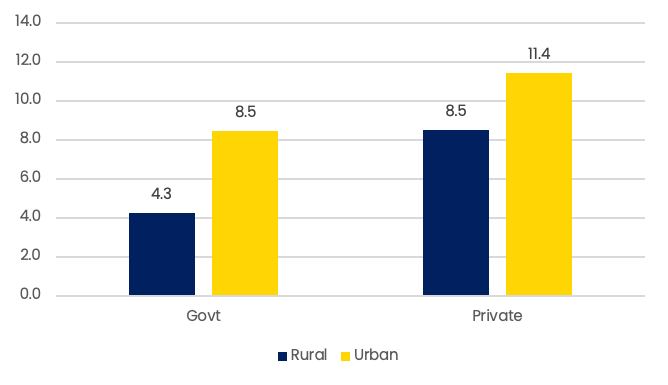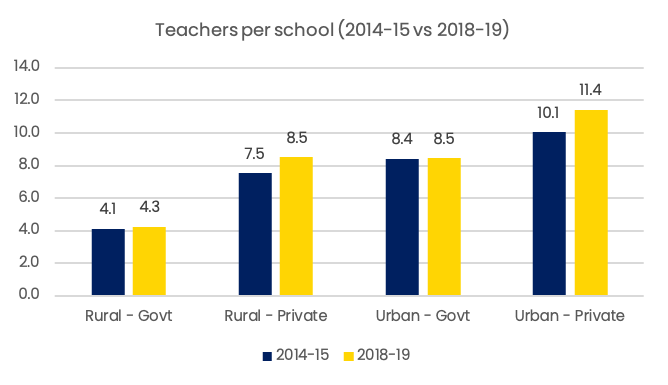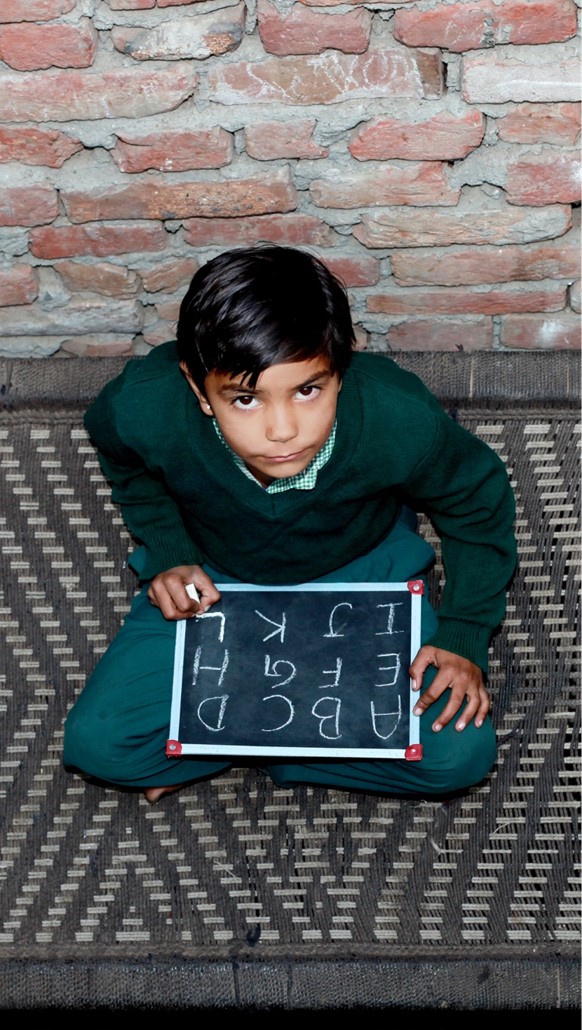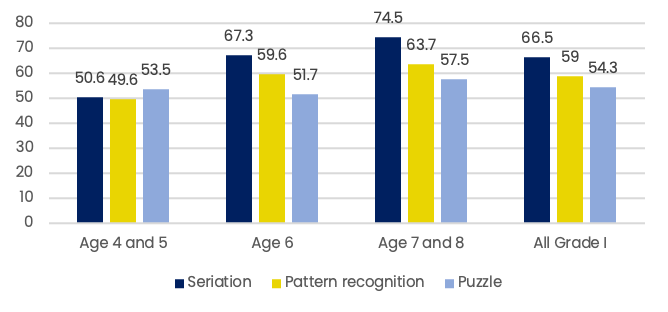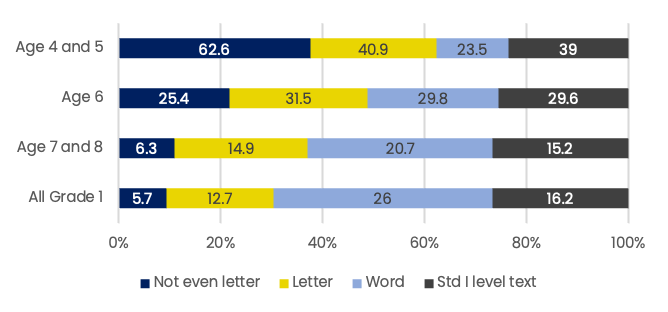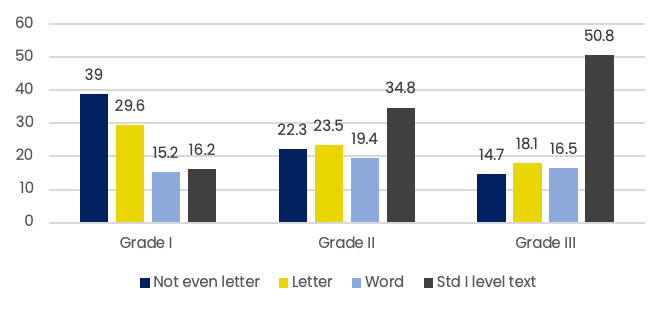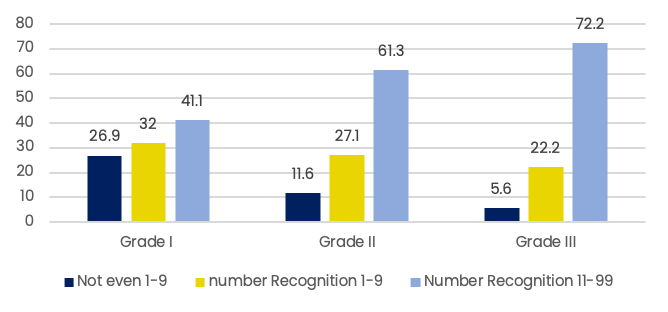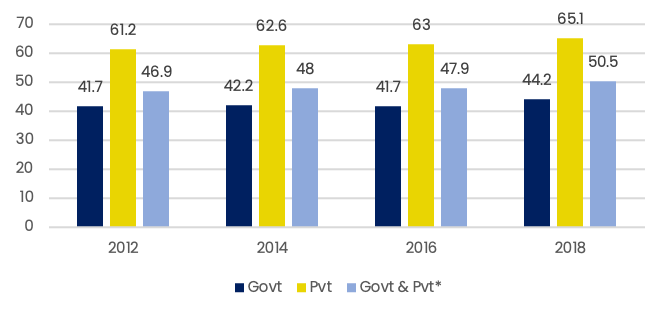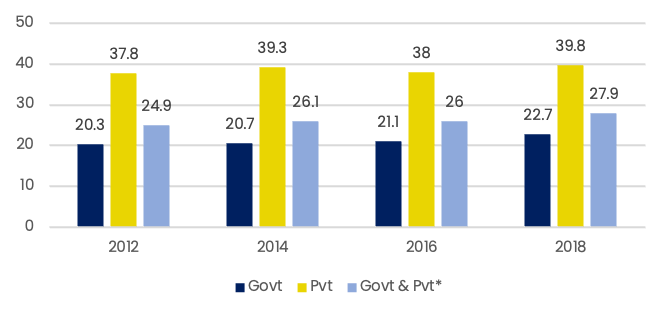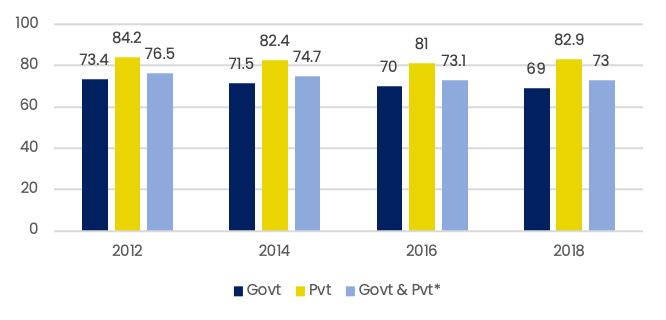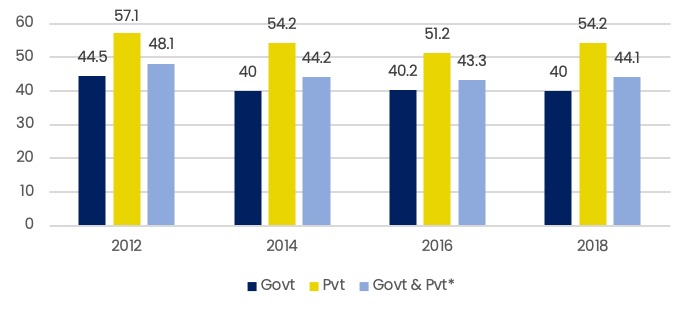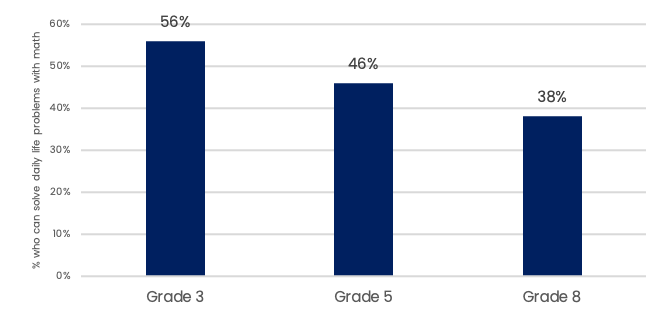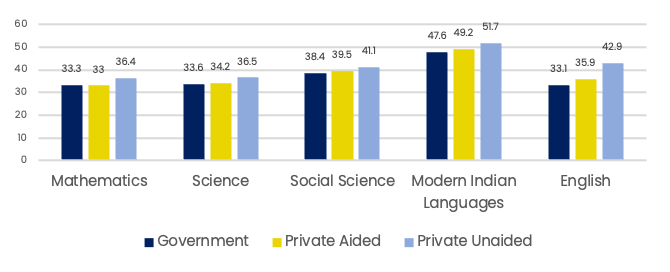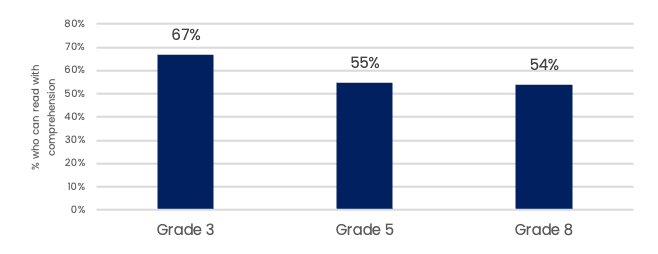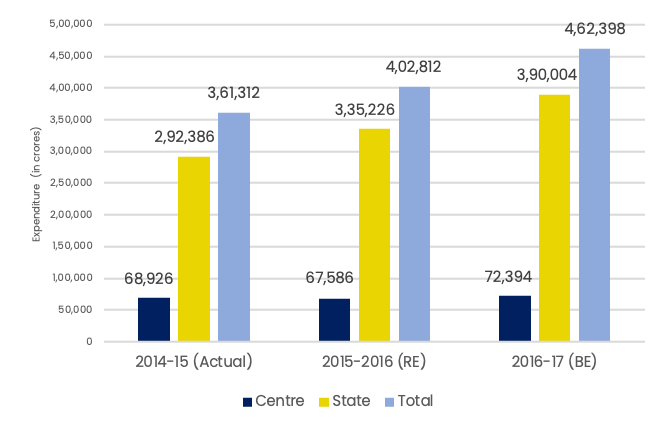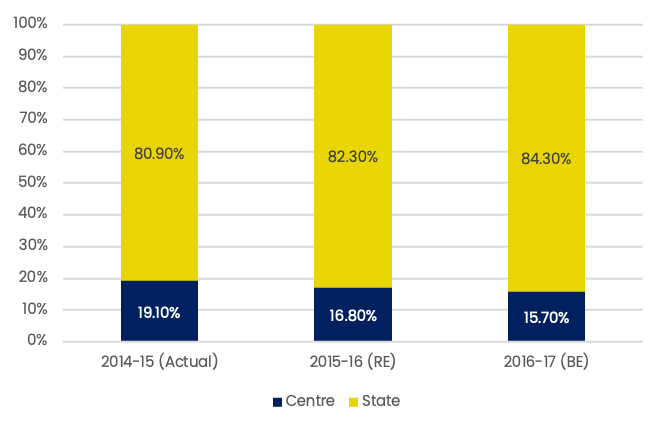India has the largest school education system in the world: ~25 crore children enrolled across ~15 lakh schools
This figure has remained fairly consistent between 2013 and 2018
Nearly 50% of these ~25 crore children attend primary grades...
...however enrolment in primary grades steadily declined between 2013 and 2018
This figure has remained fairly consistent between 2013 and 2018
- This observation is in line with theEconomic Survey of India 2018-19
- The survey notes that India is set to witness a sharp slowdown in population growth in the next two decades. The population in the 0-19 age bracket has already peaked due to sharp declines in total fertility rates (TFR) across the country
- The southern states, Himachal Pradesh, Punjab, West Bengal and Maharashtra now have fertility rates well below the replacement rate
Enrolment by level of education
Source: DISE
Annual population growth rate in India (percent)
Source: EconomicSurvey 2018-19
While the number of schools and students remained fairly constant between 2013 and 2018, the number of teachers saw a consistent rise...
Number of teachers grew from 82lakh to 92 lakh during this period
Number of teachers (5-year trend)
...resulting in the pupil-teacher ratio (PTR) declining from ~31 to ~27 pupils per teacher
- For most states, the PTR was well below or close to the ideal PTR (30:1) as stated by the Right to Education Act
- Bihar, Uttar Pradesh and Jharkhand were the three states that saw the steepest decline in their PTRs over the years.
These states saw a rise in number of teachers as well as a decline in student enrolment during this period
- Karnataka was the only state whose PTR increased (by 1.3) during this 5-year period
Pupil-teacher ratio (5-year trend)
Number of schools with zero or one teacher also saw a decline
- Among large states, Andhra Pradesh, Jharkhand and Madhya Pradesh had the highest proportion of zero or one teacher in schools
- 25% of schools in Arunachal Pradesh had zero or one teacher
- Chandigarh, Dadra & Nagar Haveli, Lakshadweep and Puducherry were the only states where no school had less than two teachers
Number of schools with zero or one teacher
Most of India’s 15 lakh schools are in rural areas, accounting for 85% of all schools
Percentage share of rural (85%)and urban (15%) schools remained consistent between 2013 and 2018
Number of schools (rural/urban)
Number of schools (rural/urban)
These 85% of schools in rural India had a student enrolment rate of ~71%
Rural locations constitute 85% of schools and 71% of enrolment in the country
Number of schools by location (2018-19)
Number of students by location (2018-19)
Commensurately, three quarters of all teachers were from rural India
- Number of teachers saw growth in both rural and urban locations
- In urban India, number of teachers grew from 21 lakh to 25 lakh between 2013 and 2018
- During the same time, number of teachers in rural India grew from 61 lakh to 67 lakh
Number of teachers (rural/urban)
Number of teachers (rural/urban)
Of India’s total schools, ~70% or~11 lakh were government schools, whose share, however, was declining...
- The share of private schools increased by ~5 percentage points (pp) between 2013 and 2018
- Although government schools did not see any significant change in numbers, their share decreased by ~2pp
Schools by management type (2018-19)
Number of teachers (rural/urban)
Student enrolment in private schools increased
- Total private school enrolment as well as percentage share of private schools saw a steady increase since 2013-14
- During the same time, government enrolment increased briefly in 2014-15, declining thereafter
- This growth in private school enrolment was seen across states during this 5-year period
Enrolment by management type
While there were more government schools (77%) in rural India, private schools(55%) were more prevalent in urban areas
- There was a slight decline in the share of government schools in both rural and urban India
- Private schools saw an overall increase of 5pp in India; they grew by 7pp in urban areas and by 4.5pp in rural areas
Percentage share of schools by management type (rural)
Percentage share of schools by management type (urban)
Commensurately, more students in rural India enrol in government schools, while students in urban India attend private schools
- Enrolment share of private schools grew in both rural (6.48pp) and urban (~8pp)locations
Enrolment by management type (rural)
Enrolment by management type (urban)
Uttar Pradesh, Mizoram and Uttarakhand saw the biggest shift towards private schools
- Most states saw an increase in the share of private schools
- In contrast, private school share declined in Tripura, Telangana, and the Andaman and Nicobar Islands
Enrolment by management type
In both rural and urban India, private schools had more students per school than government schools
- Government schools had 111 and 234 students per school in rural and urban areas, respectively. In comparison, private schools had 207 and 299 students per school in rural and urban areas, respectively
- Between 2013 and 2018 students per school saw a declining trend; although this appeared more pronounced for private schools
Students per school (2018-19)
Students per school (2014-15 vs 2018-19)
Although most of India’s teachers taught in government schools, their percentage share saw a decline
- Share of teachers in government schools declined from 56% to 53.8% between 2013 and 2018
- During the same period, the number of private school teachers saw a 8pp increase from 29.4% to 37%
Number of teachers by management type (2018-19)
Percentage share of teachers by management type
Like students per school, private schools also had more teachers per school than their government counterparts
- Government schools in urban areas (8) had double the number of teachers (per school) than those in rural (4) areas
- Between 2013 and 2018, teachers per school saw an upward trend across private and government schools, in both rural and urban India
Teachers per school (2018-19)
Teachers per school (2014-15 vs 2018-19)
Learning outcomes remained consistently low
Learning outcomes in Indian primary education have been consistently low. Even though children are moving up from one grade to another, few master the grade-level competencies expected of them
ASER, based on a sample of schools in all rural districts, shows that 72% of grade 5 children from rural India cannot do simple division problems. The percentage of students who can correctly do a three-digit to one-digit division problem reduced from 68% in 2010 to 43% in 2018
NAS cycle 3 and 4 for grade 5 revealed that 19 out of 31 states/union territories which participated in both cycles show a decline in language and math outcomes in government schools
The outcomes are low across all categories of schools, although the problem is particularly acute in government schools with affordable private schools performing slightly better on an average. High fee paying private schools achieve significantly better outcomes than both school types but lower than international averages*
Grade I : Disaggregating performance by age – older children were found do to better than younger children
- Many 4 and 5-year old children were able to comfortably do several of the cognitive activities
- Performance of Grade I children on cognitive early language and early numeracy was strongly related to their age. Older children did better at all tasks
- For example, within the Grade I cohort almost no children age and can read Grade I level text (5.7%). This proportion increased steadily with age, with 12.7% of 6-year-olds and 26% of 7 and 8 year-olds in Grade table to do
Children in Grade I who can correctly do cognitive tasks by age
Distribution of children’s reading ability in Grade I by age (2019)
Grade I to III: Yet 50% of Grade III students could not meet expectations of Grade 1 level reading abilities
- Children’s foundational skills improve with each subsequent grade. But even by Grade III, a substantial percentage of students were well behind where they were expected to be by end of Grade I
- For e.g., children's ability to read Grade I level text improved from 34.8% of children in Grade II to 50.8% in Grade II, This meant that half of the children in Grade III were already at least two years behind where the curriculum expected them to reach
- Similarly, 41.1% of students in Grade I could recognize 2-digit numbers, while 72.2% in Grade III could do so
Distribution of children’s reading ability within each grade
Distribution of children’s ability to recognize numbers within each grade
By Grade V: 51% could read a Grade II level text and 28% could do division
- Private schools score 20.9pp higher than government schools in reading and 17pp higher in math
- Slightly more than half of the children enrolled in Grade V can read at least a Grade II level text. This figure had inched up from 47.9% in 2016 to 50.5% in 2018
- Percentage of Grade V students across India who could do division increased from 24.9% to 27.9% between 2012 and 2018. This rise was seen in both private and government schools
Children who can read Grade II level text inGrade V (%)
Children who can do division in Grade V (%)
By Grade VIII: 73% could read aGrade II level text and 44% could do division
- The gap between private and government schools is smaller in Grade VIII than in Grade V. Private schools scored 14pp higher in both reading and math
- Proportion of Grade VIII students in India who could read at least a Grade II level text declined from 76.5% in 2012 to 73% in 2018. The decline was seen across private and government schools
- Currently, about 44% of Grade VIII students can solve a 3-digit by 1-digit division problem correctly. This too saw a decline across private and government schools since 2012
Children who could read Grade II
level text in Grade VIII (%)
Children who could do division
in Grade VIII (%)
Tested at their level, 62% of Grade VIII students could not solve daily life problems using math
- 67% of Grade III students could read small texts with comprehension; number decreased to 54% by Grade VIII
- 56% of Grade III students could use basic math to solve daily life problems; number decreased to 38% by Grade VIII
- Grade X students performed best in languages and poorly in math and science
Students who can solve daily life problems using math (%)
Average performance of students(Grade X)
Students who can read with comprehension (%)
Budgeted expenditure on education saw steady increase between 2014 and 2017
- Budgeted expenditure on education increased from INR 3.6 lakh crore in 2014-15 to INR 4.6 lakh crore in 2016-17
- States drove ~80% of budgeted expenditure towards education
Percentage contribution to budgeted expenditure (center vs state)
Total expenditure (center +state) as a percentage of GDP saw an upward trend during the 2006–2016 decade
- Center’s expenditure as a percentage of GDP remained consistent
- State expenditure, as a percentage of GDP, increased steadily during the same period
Expenditure on education as %age of GDP
Among large states, Assam had the highest education expenditure as percentage of GSDP
- Among large states, Uttar Pradesh, Jammu and Kashmir, and Uttar Pradesh spent greater than 5% of their GSDP on education
- Among small states, Manipur, Mizoram and Nagaland had the highest education expenditure as a percentage of their GSDP
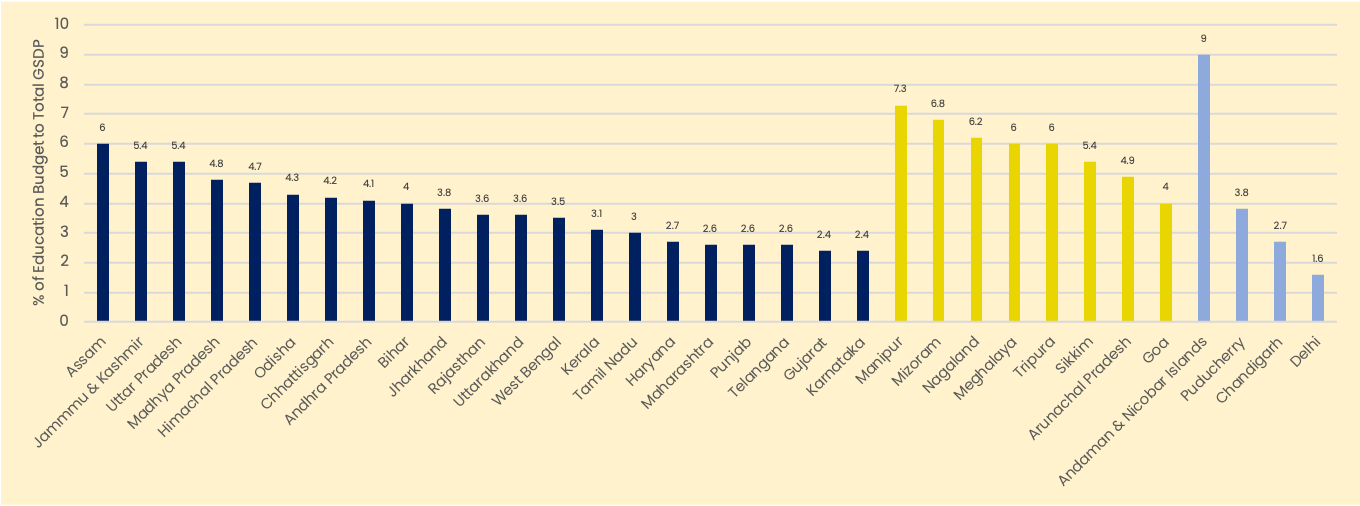
Contributors
Mayank Bhushan
Pranathi Iyer*
Pratibha Joshi
Shubhra Mittal
Niharika Ohri
Sudhanshu Sharma
Acknowledgments:
We are grateful to colleagues at the Central Square Foundation for many insightful discussions. We would especially like to thank Bikkrama Daulet Singh, Shaveta Sharma Kukreja, Dr Jayshree Oza, and Praveen Khanghta for their advice and support since the inception of this report.Special thanks to Noopur Abhishek, Atul Bhargava, Saurabh Bains, Pritika Bathija, Garima Duggal, Shruti Gogia, and Rhea Handa for connecting us with partner organisations that were integral to the education response to the COVID-19 pandemic. We are grateful to Madhi Foundation, Language and Learning Foundation, Leadership for Equity,Top Parent, Rocket Learning, Chimple, Humana People to People India, iDream Education, eVidyaloka, TagHive, Nalanda Project, and 321 EducationFoundation for detailed responses to our questions. We are indebted to our technical and state partners for invaluable information, advice, and insights. This report would not have been possible without the advice and inputs from Tania Goklany. We would also like to thank Nandita Sengupta, Saon Bhattacharya, Kesab Karmakar and Sammak Dutta from Yellow Brickroad Media for designing the report. All errors are our own.
*Pranathi Iyer was an intern at the Research, Monitoring, Evaluation, and Learning team at CSF
For any queries, suggestions, comments or corrections, please write to us at csf.research@centralsquarefoundation.org
